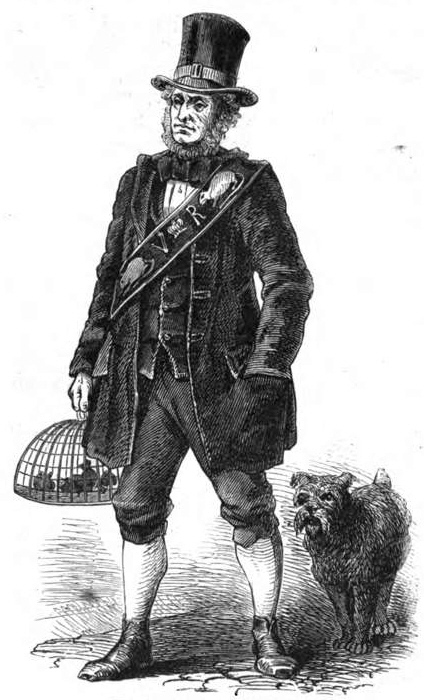During the Regency era, dogs weren’t simply pets. Many of them worked, and worked hard. From town vermin control to protecting and hunting game for country farms and estates, these dogs had a purpose beyond providing warmth on a lap or fetching sticks in a back garden.

Winter Shooting, Hares and Ptarmigan by Richard Ansdell, 1869, sold by Bonhams Auctions Edinburgh 7 November 2012.
Rum Bugher
A valuable dog. Cant.
City dogs, those in small villages all the way up to the capital city of London, had the main job of rat catching. They accompanied their human counterparts in effort to rid the populated areas of all manner of small vermin.

A Rat Catcher, from Provincial Characters by William Henry Pyne, 1804, public domain.
It was what seemed to be an ignoble profession, but by the Victorian era, two literary manuals had been published – Studies in the Art of Rat Catching and Full Revelations of a Professional Rat-Catcher After 25 Year’s Experience. One enterprising and flamboyant gent, Jack Black, even claimed to be the Royal Rat-Catcher, and so outfitted himself in a homemade uniform of breeches, scarlet waistcoat, and green topcoat, with the entire ensemble festooned with a prominent leather sash accented with cast-iron rats. And always accompanied by his faithful “ratter,” usually a terrier-type rum bugher.

Her Majesty’s Rat-catcher, author unknown, 1863, public domain.
Country rum bughers lived on everything from humble farms to majestic country estates. Those on farms were “jacks of all trades,” serving as rodent destroyers, protection against invaders (both animal and human), and hunters.

The Gamekeeper by Richard Ansdell, 19th century, location unknown.
The largest estates had a head gamekeeper as well as assistant gamekeepers to ensure their woods were full of game for sport as well as sustenance. These dogs that served with them were not pets as much as fellow employees. They were highly valued and bred for their keen sense of smell, skilled tracking, and adaptability to estate conditions. While the game keepers knew their environments well, by monitoring the number of game, rooting out poachers, and keeping statistics of the hunts, their rum bughers provided the “paws on the ground” for every aspect of it all. These dogs were kenneled and cultivated – essentially staff – and very valued.

The Gamekeeper by Hugh Cameron, 19th century, Aberdeen Art Gallery and Museums.
If the gamekeeper and his staff did their jobs correctly, hunts ran smoothly and legally, fresh game was readily available at the owner’s wish, and predators were well-controlled.

Pointers Going Out With Sportsmen, from W.H. Scott’s British Field Sports, 1820, public domain.
Next week I’ll wrap up my April look at dogs of the Regency era with specific breeds – and how different many of them look from their modern cousins.
- Slang term taken from the 1811 Dictionary of the Vulgar Tongue.
- You know you’re curious and have plenty of extra time on your hands. Go peruse Studies in the Art of Rat Catching and Full Revelations of a Professional Rat-Catcher After 25 Year’s Experience for yourself.
- Read up on The Rat-Catcher’s Art at The Guardian.
- Learn much more about Regency era gamekeepers at Sharon Lathan’s informative blog, especially her post Gamekeepers: Wardens of the Estate’s Wildlife.
- And we can thank Mimi Matthews for The Care and Kenneling of 19th Century Foxhounds and Sporting Dogs.

This post is spot-on for me. My present project concerns a sporting lord who nearly met his end on a pair of boar tusks, were it not for a hunting terrier.
LikeLiked by 1 person
Dogs are fierce protectors! And when we hear terrier today, we tend to think Jack Russells and Yorkies, but there are stout, bulky dogs in this group, like the Bulls and Airedales. I hope you’ll be sharing “the rest of your story.”
LikeLike